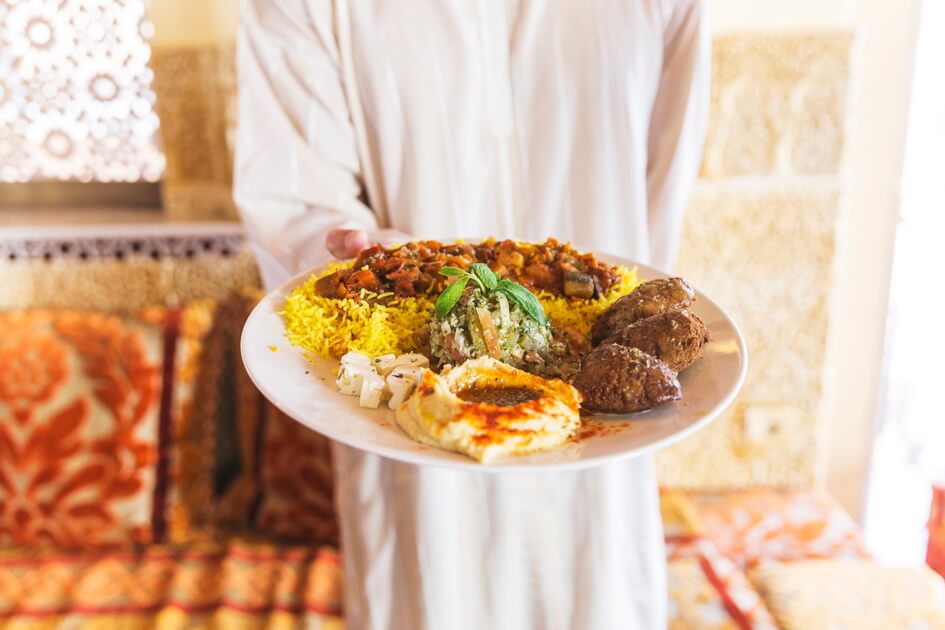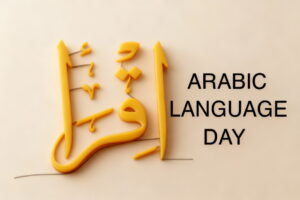
Arabic Through Food: Learn Jordanian Cuisine and Vocabulary Together
Food is more than just something to eat; it’s a doorway into culture, history, and daily life. If you’ve ever wanted to make your Arabic learning more exciting, Jordanian cuisine is the perfect place to start. The dishes, smells, and conversations that happen around the table can turn your study sessions into something fun, memorable, and full of meaning.
You can learn a lot about a culture through its food, and Jordanian cuisine gives you both flavor and language. From the first sip of strong qahwa (قهوة) to a bite of mansaf, each dish tells a story. When you connect food with Arabic words, you don’t just memorize vocabulary you live it.
Table of Contents
ToggleDiscover How Combining Cooking and Arabic Creates Unforgettable Learning Experiences
Cooking isn’t just about mixing ingredients; it’s about action, repetition, and fun. That’s exactly what makes it a great way to learn Arabic. When you hear, speak, and use new words while preparing food, you train your brain to link meaning with experience.
For example, learning Lahmeh (لحمة) for “meat” while actually cooking lamb stew makes the word stick instantly. It’s the same with ruzz (رُزّ) for “rice” as you stir the pot. Instead of memorizing long lists, you build real-life associations that last much longer.
Jordanian cuisine vocabulary connects what you taste, smell, and see with what you say. That connection makes language learning come alive.
Why Food Vocabulary Sticks in Your Memory Longer Than Textbook Words?
Our brains remember best when learning involves the senses. Taste, smell, and touch all work together to help you recall information more easily. When you learn Arabic through food, you don’t just read, you experience.
Let’s say you learn the word ‘asal (عسل) for “honey.” Reading it once in a book may not help much, but using it when you drizzle honey on knafeh (كنافة) makes it unforgettable. Every time you see or taste it again, the Arabic word will come back naturally.
That’s why learning through Jordanian cuisine works so well. It keeps your mind active and connected to real life. The words become part of your daily actions, rather than something to memorize for a test.
Essential Kitchen Arabic: Words You’ll Use Immediately
Cooking is full of movement and description, so you’ll need a few words right away. These will help you read recipes, talk with others, and understand cooking videos in Arabic.
Cooking Actions and Kitchen Tools
Start with basic tools and actions. You’ll use them all the time:
- Maعlaqa (معلقة) – Spoon
- Kaaseh (كاسة) – Cup
- Sikin (سكين) – Knife
- Tanjara (طنجرة) – Pot
- Yodakhkhin (يدخّن) – It smokes (used for cooking heat)
Colors, Textures, and Tastes
Please make the adjustment found below in yellow:
Describing food is half the fun of Jordanian cuisine! When enjoying meals, it’s helpful to know words that talk about temperature, portion sizes, colors, textures, and tastes:
1- Temperature & Portion Size
- Sakhin (ساخن) – Hot
- Baared (بارد) – Cold
- Kbeer (كبير) – Big
- Zgheer (صغير) – Small
- Kefaya (كفاية) – Enough
2- Colors
- Ahmar (أحمر) – Red
- Akhdar (أخضر) – Green
- Asfar (أصفر) – Yellow
- Bunni (بني) – Brown
3- Textures
- Na’em (ناعم) – Soft
- Qassi (قاسي) – Hard
- Moqarmash (مقرمش) – Crunchy
- Raqiq (رقيق) – Thin/Delicate
4- Tastes
- Hilou (حلو) – Sweet
- Murr (مرّ) – Bitter
- Haamed (حامض) – Sour
- MaaleH (ماالح) – Salty
- Haarr (حار) – Spicy/Hot
Action in Your Kitchen
As you cook, try speaking the words out loud. Say them while you chop, stir, and taste. This helps you connect movement with meaning. Before long, you’ll start thinking in Arabic while you cook.
Jordanian Staples: Learn the Food That Defines a Culture
Jordanian cuisine reflects family, generosity, and tradition. Each dish carries pride and warmth, and learning their names helps you understand the culture behind them.
1. Mansaf: The National Dish Vocabulary
Mansaf is more than a meal; it’s a symbol of Jordanian hospitality. It brings people together for celebrations, weddings, and family gatherings. To describe it in Arabic, you’ll need:
- Lahmeh (لحمة) – Meat
- Ruzz (رُزّ) – Rice
- Jameed (جميد) – Dried yogurt
These words alone will open conversations anywhere in Jordan. Try saying them while watching a local cooking video or eating the dish yourself.
Mezze Spread: Small Plates, Big Vocabulary
Jordan cuisine vocabulary grows quickly once you start with mezze the small plates that begin most meals. Each dish offers a new word to learn and a taste to remember:
- Hummus (حمّص) – Chickpeas
- Mtabbal (متبل) – Eggplant dip
- Warra ‘Ainab (ورق عنب) – Stuffed grape leaves
- Khubez (خبز) – Bread
Say these words as you serve or order them. You’ll not only learn faster but also sound more natural when you speak Arabic.
Sweet Endings: Dessert Terminology
Desserts are a lovely way to end any Jordanian meal and a fun way to learn Arabic too. Here are a few sweet words to add to your vocabulary:
- Knafeh (كنافة) – Sweet cheese pastry
- ‘Asal (عسل) – Honey
Desserts connect language with pleasure. Every time you enjoy coffee or knafeh, your Arabic vocabulary grows without effort.
Market to Table: Shopping Vocabulary for a Real Jordanian Experience
Shopping at a souq (market) is one of the best ways to use Jordanian cuisine vocabulary in daily life. It’s noisy, friendly, and full of conversations that help you practice.
At the Souq (Market):
Here are a few helpful phrases:
- Bi’addesh? (بِقْدِش؟) – How much?
- El-Hisaab min fadlak (الحساب من فضلك) – The bill please
- Mumkin aakhud shwayya min haada? (ممكن آخذ شوية من هادا؟) – Can I take a little of this?
Use these expressions while pointing to fruits, spices, or pastries. The sellers will often smile and help you pronounce them better.
Interacting with Vendors:
Knowing a few polite phrases goes a long way:
- Salaamu ‘alaykum (السلام عليكم) – Peace be upon you (greeting)
- Kayf al-Haal? (كيف الحال؟) – How are you?
- Shukran (شكراً) – Thank you
- Mumkin ajareb shwayy min haada? ممكن أجرب شوي من هادا؟ – Can I Try this?
These are small but powerful words that make you feel part of the local rhythm. Each exchange teaches you something new about Jordanian culture.
Cooking Lesson Arabic: Follow Recipes in Jordanian Style
Cooking with Arabic instructions helps you understand numbers, time, and measurements naturally. Here are some words that will help you follow recipes easily:
1- Measurement and Quantity Terms
- Kaaseh (كاسة) – Cup
- Maعlaqa (معلقة) – Spoon
- Kbeer (كبير) – Big
- Zgheer (صغير) – Small
- Kefaya (كفاية) – Enough
2- Time and Temperature Words
- Saaعa (ساعة) – Hour
- Daqeeqa (دقيقة) – Minute
- Sakhin (ساخن) – Hot
- Baared (بارد) – Cold
- Yodakhkhin (يدخّن) – It smokes
When you use these words while cooking, they stop being abstract terms. They become part of your hands and actions. That’s how real fluency begins through repetition and experience.
Cultural Bites: Dining Etiquette and Food Traditions
Language is more than grammar; it’s how people connect. In Jordanian culture, eating together shows respect and warmth. Here are phrases that add meaning to your conversations:
- TafaDDal (تفضّل) – Please (inviting someone)
- SaHtain (صحتين) – “Double health,” said before eating
- Allah yisallem idaik (الله يسلم ايديك) – Said to thank the cook
Using these expressions shows you understand both words and manners. It’s a beautiful way to blend language with respect.
From Kitchen Conversations to Fluency
Learning Arabic doesn’t have to be confined to a classroom. It can happen while you cook, eat, and talk. Jordanian cuisine gives you that opportunity every day. You build your confidence one dish, one word, and one conversation at a time.
Start small, make a bowl of hummus or say your favorite dish in Arabic. Every meal can become a mini lesson that teaches you new words, pronunciation, and cultural understanding.
Food is universal, but language makes it personal. When you mix the two, you create something unforgettable.
FAQ
How effective is learning Arabic through food and cooking?
Very effective. It connects words with real experiences, making them easier to remember and use naturally.
What are the most important Arabic food terms to learn first?
Start with basics like lahmeh (لحمة), ruzz (رُزّ), khubez (خبز), and qahwa (قهوة). They appear in almost every meal.
Which Jordanian dish is best for beginners to start with?
Try mansaf for traditional flavors or hummus for something simple and widely known.
Are food terms different in Jordanian Arabic compared to Modern Standard Arabic?
Some are. For example, pronunciation and slang can change slightly. Learning Jordanian cuisine vocabulary gives you local authenticity.
How can I practice Arabic food vocabulary if I can’t travel to Jordan?
Cook Jordanian recipes at home, watch Arabic cooking shows, and say the words out loud while preparing meals. You’ll feel connected even from far away.



